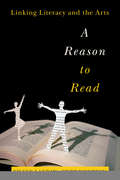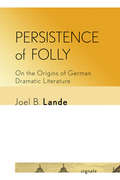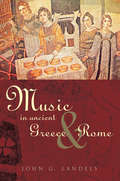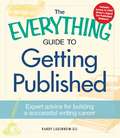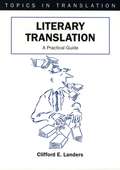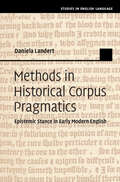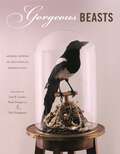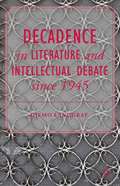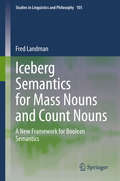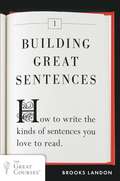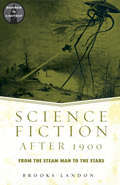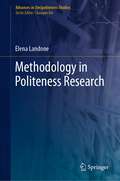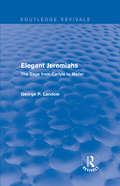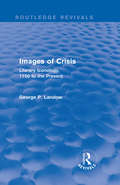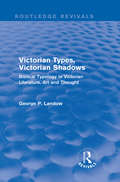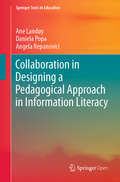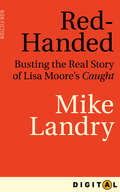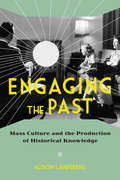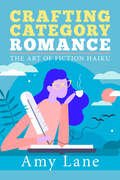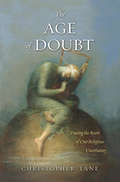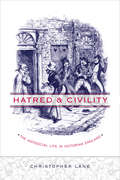- Table View
- List View
A Reason to Read: Linking Literacy and the Arts
by Eileen Landay Shirley Brice Heath Kurt WoottonA Reason to Read is the culminating work of the ArtsLiteracy Project, an ambitious and wide-ranging collaborative that aims to promote literacy through rich and sustained instruction in the arts. At the heart of the book is the "Performance Cycle," a flexible framework for curriculum and lesson planning that can be adapted to all content areas and age groups. Each of the book's main chapters delineates and explores a particular component of the cycle. A practical, readable, and inspiring book, A Reason to Read will be of immeasurable help to school teachers, education leaders, and all who have a stake in promoting literacy and the arts in today's schools.
A Reason to Read: Linking Literacy and the Arts
by Eileen Landay Kurt WoottonA Reason to Read is the culminating work of the ArtsLiteracy Project, an ambitious and wide-ranging collaborative that aims to promote literacy through rich and sustained instruction in the arts. At the heart of the book is the &“Performance Cycle,&” a flexible framework for curriculum and lesson planning that can be adapted to all content areas and age groups. Each of the book&’s main chapters delineates and explores a particular component of the cycle. A practical, readable, and inspiring book, A Reason to Read will be of immeasurable help to school teachers, education leaders, and all who have a stake in promoting literacy and the arts in today&’s schools.
Persistence of Folly: On the Origins of German Dramatic Literature (Signale: Modern German Letters, Cultures, and Thought)
by Joel B. LandeJoel B. Lande’s Persistence of Folly challenges the accepted account of the origins of German theater by focusing on the misunderstood figure of the fool, whose spontaneous and impish jest captivated audiences, critics, and playwrights from the late sixteenth through the early nineteenth century. Lande radically expands the scope of literary historical inquiry, showing that the fool was not a distraction from attempts to establish a serious dramatic tradition in the German language. Instead, the fool was both a fixture on the stage and a nearly ubiquitous theme in an array of literary critical, governmental, moral-philosophical, and medical discourses, figuring centrally in broad-based efforts to assign laughter a proper time, place, and proportion in society.Persistence of Folly reveals the fool as a cornerstone of the dynamic process that culminated in the works of Lessing, Goethe, and Kleist. By reorienting the history of German theater, Lande’s work conclusively shows that the highpoint of German literature around 1800 did not eliminate irreverent jest in the name of serious drama, but instead developed highly refined techniques for integrating the comic tradition of the stage fool.
Music in Ancient Greece and Rome
by John G LandelsMusic in Ancient Greece and Rome provides a comprehensive introduction to the history of music from Homeric times to the Roman emperor Hadrian, presented in a concise and user-friendly way. Chapters include: * contexts in which music played a role * a detailed discussion of instruments * an analysis of scales, intervals and tuning * the principal types of rhythm used * and an exploration of Greek theories of harmony and acoustics.Music in Ancient Greece and Rome also contains numerous musical examples, with illustrations of ancient instruments and the methods of playing them.
The Everything Guide to Getting Published
by Randy Landenheim-GilYou've always wanted to be an author. And now you're ready to get started. But getting that manuscript written and published is not so easy. In this guide, you'll find the expert advice of industry insiders--editors, agents, and successful authors. You'll learn tips and tricks about submissions, how to write a killer query, and even how to navigate the uncertain waters of self-publishing and e-books. Whether you're a beginner or an experienced writer, here is everything you need to take an idea to the printed page, including: Guidance on planning a writing career and building a platform Surefire ways to get a submission taken seriously Contract negotiation tips from the pros An in-depth exploration of self-publishing and e-books This essential guide also includes an exclusive link to a FREE get-published webinar, sponsored by the prestigious writing magazine Writer's Digest. This multimedia package is loaded with insider tips and professional techniques--all you need to turn writing from a hobby into a profession!
The Everything Guide to Getting Published: Expert advice for building a successful writing career
by Randy Landenheim-GilYou've always wanted to be an author. And now you're ready to get started. But getting that manuscript written and published is not so easy. In this guide, you'll find the expert advice of industry insiders--editors, agents, and successful authors. You'll learn tips and tricks about submissions, how to write a killer query, and even how to navigate the uncertain waters of self-publishing and e-books. Whether you're a beginner or an experienced writer, here is everything you need to take an idea to the printed page, including:Guidance on planning a writing career and building a platformSurefire ways to get a submission taken seriouslyContract negotiation tips from the prosAn in-depth exploration of self-publishing and e-books This essential guide also includes an exclusive link to a FREE get-published webinar, sponsored by the prestigious writing magazine Writer's Digest. This multimedia package is loaded with insider tips and professional techniques--all you need to turn writing from a hobby into a profession!
Literary Translation
by Clifford E. LandersIn this book, both beginning and experienced translators will find pragmatic techniques for dealing with problems of literary translation, whatever the original language. Certain challenges and certain themes recur in translation, whatever the language pair. This guide proposes to help the translator navigate through them. Written in a witty and easy to read style, the book's hands-on approach will make it accessible to translators of any background. A significant portion of this Practical Guide is devoted to the question of how to go about finding an outlet for one's translations.
Methods in Historical Corpus Pragmatics: Epistemic Stance in Early Modern English (Studies in English Language)
by null Daniela LandertBased on an extensive corpus-based study, this revealing book explores how epistemic stance is expressed in the early modern period, and in doing so, presents new methodologies for using corpora to investigate issues in historical pragmatics. It provides a new, corpus-driven method for the analysis of pragmatic functions that rely on context-dependent interpretations. By retrieving passages that include a high-density of the pragmatic function under investigation, the subsequent analysis can reveal previously neglected forms and context-dependent factors. It includes four empirical studies that apply the method to the analysis of epistemic stance in four Early Modern English corpora, the result of which emphasise the importance of context for the expression of stance. It also includes an appendix with inventories of Early Modern English stance expressions, offering starting points for further research studies. It is essential reading for researchers and students in historical pragmatics and corpus pragmatics.
Gorgeous Beasts: Animal Bodies in Historical Perspective (Animalibus)
by Joan B. Landes Paula Young Lee Paul YoungquistGorgeous Beasts takes a fresh look at the place of animals in history and art. Refusing the traditional subordination of animals to humans, the essays gathered here examine a rich variety of ways animals contribute to culture: as living things, as scientific specimens, as food, weapons, tropes, and occasions for thought and creativity. History and culture set the terms for this inquiry. As history changes, so do the ways animals participate in culture. Gorgeous Beasts offers a series of discontinuous but probing studies of the forms their participation takes. This collection presents the work of a wide range of scholars, critics, and thinkers from diverse disciplines: philosophy, literature, history, geography, economics, art history, cultural studies, and the visual arts. By approaching animals from such different perspectives, these essays broaden the scope of animal studies to include specialists and nonspecialists alike, inviting readers from all backgrounds to consider the place of animals in history and art. Combining provocative critical insights with arresting visual imagery, Gorgeous Beasts advances a challenging new appreciation of animals as co-inhabitants and co-creators of culture.Aside from the editors, the contributors are Dean Bavington, Ron Broglio, Mark Dion, Erica Fudge, Cecilia Novero, Harriet Ritvo, Nigel Rothfels, Sajay Samuel, and Pierre Serna.
Decadence in Literature and Intellectual Debate since 1945
by Diemo LandgrafBridging the gap between decadence as it is traditionally understood in literary and cultural studies and its relevance to current phenomena, this interdisciplinary collection examines literary texts and movies from Europe and the United States since 1945.
Iceberg Semantics for Mass Nouns and Count Nouns: A New Framework for Boolean Semantics (Studies in Linguistics and Philosophy #105)
by Fred LandmanIceberg semantics is a new framework of Boolean semantics for mass nouns and count nouns in which the interpretation of a noun phrase rises up from a generating base and floats with its base on its Boolean part set, like an iceberg. The framework is shown to preserve the attractive features of classical Boolean semantics for count nouns; the book argues that Iceberg semantics forms a much better framework for studying mass nouns than the classical theory does. Iceberg semantics uses its notion of base to develop a semantic theory of the differences between mass nouns and count nouns and between different types of mass nouns, in particular between prototypical mass nouns (here called mess mass nouns) like water and mud versus object mass nouns (here called neat mass nouns) like poultry and pottery. The book shows in detail how and why neat mass nouns pattern semantically both with mess mass nouns and with count nouns. Iceberg semantics is a compositional theory and in Iceberg semantics the semantic distinctions defined apply to noun phrases of any complexity. The book studies in depth the semantics of classifier noun phrases (like three glasses of wine) and measure noun phrases (like three liters of wine). The classical wisdom is that classifier interpretations are count. Recent literature has argued compellingly that measure interpretations are mass. The book shows that both connections follow from the basic architecture of Iceberg semantics.Audience: Scholars and students in linguistics - in particular semantics, pragmatics, computational linguistics and syntax – and neighbouring disciplines like logic, philosophy of language, and cognitive science.
Building Great Sentences
by Brooks LandonBased on the bestselling series from The Great Courses, Building Great Sentences celebrates the sheer joy of language--and will forever change the way you read and write. Great writing begins with the sentence. Whether it's two words ("Jesus wept. ") or William Faulkner's 1,287-word sentence in Absalom! Absalom!, sentences have the power to captivate, entertain, motivate, educate, and, most importantly, delight. Yet, the sentence-oriented approach to writing is too often overlooked in favor of bland economy. Building Great Sentences teaches you to write better sentences by luxuriating in the pleasures of language. Award-winning Professor Brooks Landon draws on examples from masters of long, elegant sentences--including Don DeLillo, Virginia Woolf, Joan Didion, and Samuel Johnson--to reveal the mechanics of how language works on thoughts and emotions, providing the tools to write powerful, more effective sentences. .
Science Fiction After 1900: From the Steam Man to the Stars (Genres in Context)
by Brooks LandonFirst published in 2003. Routledge is an imprint of Taylor & Francis, an informa company.
Lorenzo di Filippo Strozzi and Niccolo Machiavelli
by William J. LandonBy 1520, Niccolò Machiavelli's life in Florence was steadily improving: he had achieved a degree of literary fame, and, following his removal from the Florentine Chancery by the Medici family, he had managed to gain their respect and patronage. But there is one figure whose substantial contributions to Machiavelli's restoration has been hitherto neglected - Lorenzo di Filippo Strozzi (1482-1549), a younger and fabulously wealthy Florentine nobleman. As manuscript evidence suggests, Strozzi brought Machiavelli into his patronage network and aided many of his post-1520 achievements.This book is the first English biography of Strozzi, as well as the first examination of the patron-client relationship that developed between the two men. William J. Landon reveals Strozzi's influence on Machiavelli through wide-ranging textual investigations, and especially through Strozzi's Pistola fatta per la peste - a work that survives as a Machiavelli autograph, and for which Landon has provided the first ever complete English translation and critical edition.
Methodology in Politeness Research (Advances in (Im)politeness Studies)
by Elena LandoneThis book presents overviews on the specific methods for the study of verbal politeness, which is deeply and constantly involved in our social life. The text offers an original and specific synthesis of traditional and innovative methods for the study of politeness as we conceive it today: as a complex system between the individual microcosm (psychological and cognitive) and the social macrocosm (cultural and relational). The author addresses theoretical and academic issues while exploring various critical points for the future of politeness studies. The reader is provided with a coherent network, which crosses between theory, methods and tools for research. The network results in a wide range of model research that facilitates the practical understanding of the potential for each data collection technique. This monograph offers representative examples of studies of various languages and cultures and appeals to students, researchers and professionals within the field.
Elegant Jeremiahs: The Sage from Carlyle to Mailer (Routledge Revivals)
by George P. LandowLabelled "an elegant Jeremiah" by a journalist of his day, the urbane Victorian Matthew Arnold must have received the comparison with the Old Testament prophet uneasily. Writing in the 1970s, Norman Mailer seems to owe nothing to the biblical for his description of a long hot wait to buy a cold drink while reporting on the first voyage to the moon. Yet both Arnold and Mailer, George P. Landow asserts in this book, are sages, writers in the nonfiction prose form of secular prophecy, a genre richly influenced by the episodic structures and harshly critical attitudes toward society which characterize Old Testament prophetic literature. In this book, first published in 1986, Landow defines the genre by exploring its rhetoric, an approach that enables him to illuminate the relationships among representative works of the nineteenth century to one another, to biblical, oratorical, and homiletic traditions, and to such twentieth-century writers as Lawrence, Didion, and Mailer.
Images of Crisis: Literary Iconology, 1750 to the Present (Routledge Revivals)
by George P. LandowFirst published in 1982, Images of Crisis explores the premise that literature and art exploit various images to present culturally prevalent ideas, and thus create their own form of iconology. George Landow shows how the tumultuous history of the past two hundred years has resulted in a plethora of metaphors associated with moments of human crisis. Avalanches and volcanoes emerge as focal images in an aesthetic that concerns itself increasingly with the vulnerability of humanity. However, it is in the transformation of traditional religious images that the ideas of the vacant universe are most dramatically presented. Associated with this central idea are ironic transformations of other images that formerly had been associated with Christianity as paradigms of belief: the journey of Odysseus, the rainbow of the Covenant and Robinson Crusoe. Combining close textual analysis with a theory of literary iconology, this fascinating reissue will be of particular value to students with an interest in literary images, and literary and cultural history.
Victorian Types, Victorian Shadows: Biblical Typology in Victorian Literature, Art and Thought (Routledge Revivals)
by George P. LandowThe importance of typology in the study of early modern literature has long been accepted, yet students of Victorian culture have paid little attention to it. First published in 1980, this study demonstrates how biblical typology, an apparently arcane interpretative mode, had profound effects on the secular culture of the Victorian age: its art, literature and thought. George Landow considers the way in which the average English believer learned to read their Bible in terms of the types and shadows of Christ, the various ways in which Victorian poetry and hymns employed certain imagery, and the use of typological symbolism in narrative poetry, prose fiction, dramatic monologue and non-fiction. In a concluding chapter, he investigates the particularly complex, and often ironic, combinations of typological image and typological structure.
Collaboration in Designing a Pedagogical Approach in Information Literacy (Springer Texts in Education)
by Ane Landøy Daniela Popa Angela RepanoviciThis Open Access book combines expertise in information literacy with expertise in education and teaching to share tips and tricks for the development of good information literacy teaching and training in universities and libraries. It draws on research, knowledge and pedagogical practice from academia, to teach students how to sift through information to be able to distinguish the important and correct from the unusable. It discusses basic concepts and models of information literacy, as well as strategies for accessing, locating and retrieving information and methods suitable for the assessment and management of information. The book explains many concepts connected to information literacy and discusses pedagogical issues with a view to supporting the practitioner. Each chapter examines one aspect of information literacy, discusses the pedagogical challenges involved and provides suggestions for best practice.
Red-Handed: Busting the Real Story of Lisa Moore's Caught
by Mike LandryThe true stories that inspired Lisa Moore’s latest novel Caught. When journalist Mike Landry called Lisa Moore for an interview, he began by listing four names, and asking, “What do these names mean to you?” The award-winning author of Alligator and February paused and took a deep breath. Not one of the names appears in Caught, but their stories were more entwined with Moore’s fictional account of Newfoundland drug-running in the 1970s than even the author knew. In this profile of Moore, fate, fortune, freedom and the little town of Ferryland, Newfoundland, come together to form a picture of Canada’s greatest writer at the peak of her form. Originally published in Salon, New Brunswick’s home for fine art and culture in the Telegraph-Journal, Anansi Digital offers Red-Handed for the first time to a national audience.
Engaging the Past: Mass Culture and the Production of Historical Knowledge
by Alison LandsbergReading films, television dramas, reality shows, and virtual exhibits, among other popular texts, Engaging the Past examines the making and meaning of history for everyday viewers. Contemporary media can encourage complex interactions with the past that have far-reaching consequences for history and politics. Viewers experience these representations personally, cognitively, and bodily, but, as this book reveals, not just by identifying with the characters portrayed. Some of the works considered in this volume include the films Hotel Rwanda (2004), Good Night and Good Luck (2005), and Milk (2008); the television dramas Deadwood, Mad Men, and Rome; the reality shows Frontier House, Colonial House, and Texas Ranch House; and The Secret Annex Online, accessed through the Anne Frank House website, and the Kristallnacht exhibit, accessed through the Unites States Holocaust Museum website. These mass cultural texts cultivate what Alison Landsberg calls an "affective engagement" with the past, tying the viewer to an event or person and fostering a sense of intimacy that does more than transport the viewer back in time. Affect, she suggests, can also work to disorient the viewer, forcibly pushing him or her out of the narrative and back into his or her own body. By analyzing these specific popular history formats, Landsberg shows the unique way they provoke historical thinking and produce historical knowledge, prompting a reconsideration of what constitutes history and an understanding of how history works in the contemporary mediated public sphere.
Crafting Category Romance - The Art of Fiction Haiku: The Art Of Fiction Haiku
by Amy LaneCategory romance is a precise art. With such a small word count, writing the perfect category romance is a little like writing a haiku. But how do you write a book in seventeen syllables? How can you cram compelling conflict, satisfying character development, and toe-curling romantic tension into less than sixty thousand words? In Crafting Category Romance, two-time RITA™-nominated author of nearly one hundred books Amy Lane describes the rules of engagement, traps to watch out for, and how to leverage common tropes to create conflict, craft a character, develop a plot, and leave readers with a happy ever after that's different every time—all in a tidy package. With practical exercises in plot, conflict, and character development, Crafting Category Romance will teach you how to use the rigid rules and expectations of the genre to your advantage and win a loyal readership following for life.
The Age of Doubt
by Christopher LaneThe Victorian era was the first great "Age of Doubt" and a critical moment in the history of Western ideas. Leading nineteenth-century intellectuals battled the Church and struggled to absorb radical scientific discoveries that upended everything the Bible had taught them about the world. InThe Age of Doubt, distinguished scholar Christopher Lane tells the fascinating story of a society under strain as virtually all aspects of life changed abruptly. In deft portraits of scientific, literary, and intellectual icons who challenged the prevailing religious orthodoxy, from Robert Chambers and Anne Brontë to Charles Darwin and Thomas H. Huxley, Lane demonstrates how they and other Victorians succeeded in turning doubt from a religious sin into an ethical necessity. The dramatic adjustment of Victorian society has echoes today as technology, science, and religion grapple with moral issues that seemed unimaginable even a decade ago. Yet the Victorians' crisis of faith generated a far more searching engagement with religious belief than the "new atheism" that has evolved today. More profoundly than any generation before them, the Victorians came to view doubt as inseparable from belief, thought, and debate, as well as a much-needed antidote to fanaticism and unbridled certainty. By contrast, a look at today's extremes--from the biblical literalists behind the Creation Museum to the dogmatic rigidity of Richard Dawkins's atheism--highlights our modern-day inability to embrace doubt.
Hatred and Civility: The Antisocial Life in Victorian England
by Christopher LaneTo understand hatred and civility in today's world, argues Christopher Lane, we should start with Victorian fiction. Although the word "Victorian" generally brings to mind images of prudish sexuality and well-heeled snobbery, it has above all become synonymous with self-sacrifice, earnest devotion, and moral rectitude. Yet this idealized version of Victorian England is surprisingly scarce in the period's literature--and its journalism, sermons, poems, and plays--where villains, hypocrites, murderers, and cheats of all types abound.
